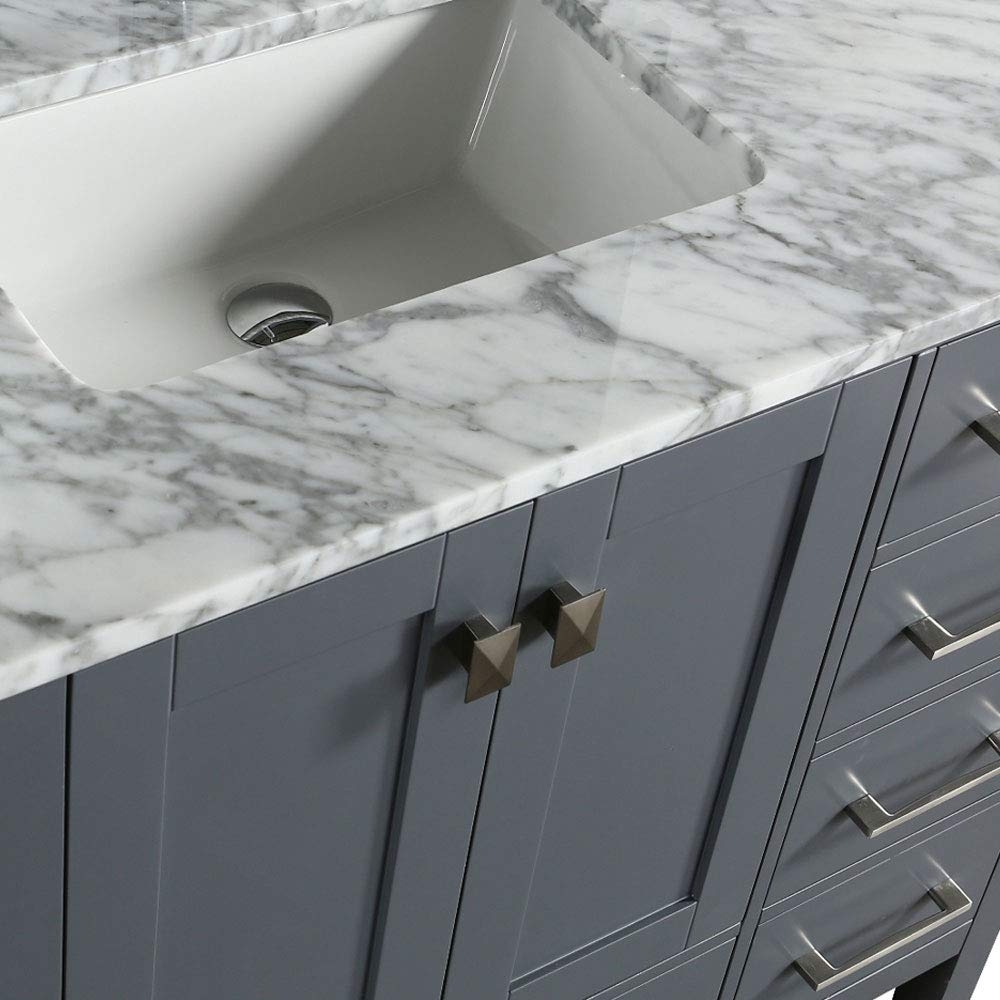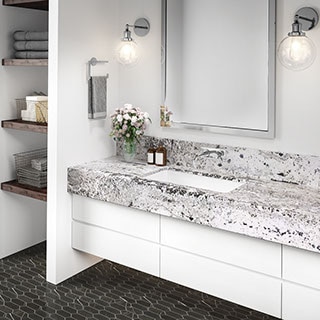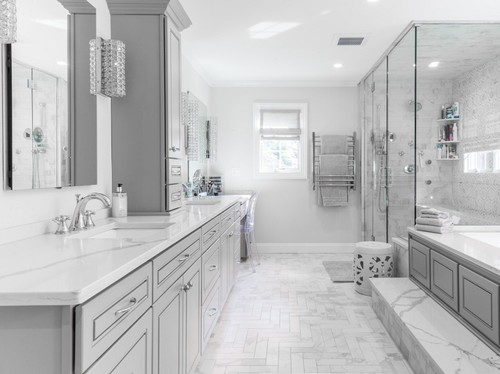When I decided to upgrade my bathroom vanity, choosing a marble countertop felt like an obvious choice. Marble has long been synonymous with luxury and elegance, instantly transforming any bathroom into a sophisticated space. It offers a unique aesthetic appeal that few other materials can match. Marble comes in a variety of colors, from classic whites and creams to rich greens, blues, and even pinks. The most popular marble for bathroom vanities tends to be Carrara, Calacatta, and Statuario, which are known for their elegant veining and timeless appearance. Each slab of marble is unique, which adds a one-of-a-kind quality to any bathroom space. The natural veining patterns in marble, with their delicate, flowing lines, give the material an artistic feel that is perfect for a focal point like a bathroom vanity.
However, one of the reasons I was initially hesitant about choosing marble for my bathroom was the material’s reputation for being high-maintenance. Marble is softer and more porous than materials like granite, which means it’s more prone to scratching, staining, and etching from acidic substances. Still, with the right care and maintenance routine, marble can remain beautiful for many years. After doing my research, I felt confident that the beauty marble would bring to my bathroom would be worth the extra effort. Plus, it’s hard to deny the luxurious feel of marble under your fingertips when you’re using your bathroom vanity daily.
When it comes to cleaning, marble requires a gentler touch compared to other materials. I make sure to clean my marble vanity with a soft cloth and a pH-neutral cleaner designed specifically for natural stone. Abrasive cleaners or acidic substances, such as vinegar or lemon juice, can cause etching, which dulls the surface of the marble. A regular cleaning routine can help preserve the shine and elegance of the marble, and I’ve found that wiping up spills immediately is the best way to prevent staining. Since marble is porous, liquids like makeup, toothpaste, or lotions can seep into the surface if left for too long, so being proactive about cleanliness is key.
One of the things I appreciate most about marble is how it instantly elevates the look of the bathroom. A marble countertop creates a bright, clean, and open feel, making the bathroom look more spacious and inviting. The reflective surface of polished marble helps to bounce light around the room, which is especially helpful in smaller or darker bathrooms. I noticed that after installing my marble vanity, the entire room felt more upscale and cohesive, even though I didn’t make many other changes. Marble has a way of making everything around it look better, which is why it has remained a popular choice for bathroom vanities throughout the years.

Despite its beauty, marble can be prone to scratching. This is particularly true in a bathroom setting where sharp objects like razors, tweezers, or jewelry are often used on the countertop. To avoid scratches, I always use a soft surface, like a towel or a mat, when handling items that could potentially damage the marble. Additionally, I try to keep my vanity free from clutter, which not only helps maintain the marble’s pristine appearance but also contributes to a more organized and tranquil bathroom environment.
One of the reasons marble is such a popular material for bathroom vanities is its versatility in terms of design. Whether your bathroom has a traditional, modern, or eclectic style, marble can seamlessly fit into almost any aesthetic. In my own bathroom, I opted for a classic white Carrara marble with subtle grey veining, which complements both the modern fixtures and the traditional elements in the space. Marble can also be paired with a wide range of sink styles, from undermount sinks to vessel sinks, giving you plenty of options when designing your bathroom vanity.
The cool-to-the-touch nature of marble is another reason why it’s so appealing for bathroom vanities. In the mornings, the cool surface feels refreshing, and I enjoy the tactile sensation of running my fingers across the smooth, polished stone. This natural cooling property also makes marble an ideal material for bathrooms in warmer climates. While the coolness can be a bit surprising on chilly mornings, it’s a feature that I’ve come to appreciate over time.

One potential downside of marble is that it can be more expensive than other countertop materials. However, I viewed the cost as an investment in both the beauty and functionality of my bathroom. Marble is a material that never goes out of style, and its durability means that it can last for decades with proper care. In the long run, I felt that the higher upfront cost was justified by the longevity and timeless appeal of marble. Plus, having a marble vanity can significantly increase the value of your home, which is something to consider if you ever plan to sell your property.
Sealing is an essential part of maintaining a marble countertop in a bathroom. Since marble is porous, it’s important to apply a high-quality sealant that helps protect the stone from absorbing liquids and developing stains. I reseal my marble vanity every six months to a year, depending on how frequently the bathroom is used. The process is fairly simple and involves applying the sealant evenly across the surface, letting it sit for a few minutes, and then wiping away any excess. Proper sealing creates an invisible barrier that enhances the durability of the marble.
While I’ve loved having a marble vanity, I’ve learned that it’s essential to be mindful of certain products and habits that can damage the stone. For example, I always make sure to place bottles of lotions, perfumes, or other personal care items on a tray rather than directly on the marble surface. This prevents any accidental spills or leaks from causing damage. Additionally, I avoid placing heavy objects on the marble, as this can cause chips or cracks, particularly near the edges. By being cautious and taking preventive measures, I’ve been able to keep my marble vanity in excellent condition.
Another consideration when choosing marble for a bathroom vanity is the edge profile. Marble countertops can be customized with a variety of edge profiles, from a simple, straight edge to more ornate designs like ogee or bullnose edges. I opted for a slightly rounded edge, which softens the look of the countertop and helps prevent chipping around the edges. The edge profile you choose can have a big impact on the overall style of your bathroom, so it’s important to consider both aesthetics and practicality when making your decision.

One of the reasons I continue to be happy with my decision to install a marble vanity is the way it enhances the overall atmosphere of the bathroom. Marble has a natural elegance that makes the space feel more relaxing and luxurious. I find that having such a beautiful vanity has made me more inclined to keep the bathroom organized and clutter-free, which, in turn, creates a more serene environment. It’s amazing how much of an impact a single element, like a marble countertop, can have on the entire feel of a room.
In addition to its aesthetic appeal, marble is also incredibly resilient when it comes to standing up to water exposure. Since bathrooms are naturally moist environments, I was concerned about whether marble could handle the constant exposure to water. However, I’ve found that as long as the marble is properly sealed, it’s highly resistant to water damage. I always wipe down the surface after using the sink or if water splashes onto the countertop, which helps prevent any potential issues.
Finally, one of the biggest benefits of having a marble countertop on your bathroom vanity is the way it adds value to your home. Marble is seen as a premium material, and having it in your bathroom can make a big difference in the overall value and appeal of your property. Whether you’re planning to stay in your home for years or you’re considering selling in the future, investing in a marble vanity is a smart choice that can provide both immediate satisfaction and long-term benefits.

Common Mistakes to Avoid
Skipping the Sealing Process: Not sealing marble regularly can lead to staining and etching. Be sure to reseal your marble vanity every 6-12 months to keep it protected from water and product spills.
Using Harsh Cleaners: Acidic or abrasive cleaners can damage the marble’s surface, causing dull spots and scratches. Stick to pH-neutral cleaners specifically designed for marble.
Leaving Spills Untreated: Since marble is porous, it can easily absorb liquids, leading to permanent stains. Always wipe up spills immediately, especially from products like makeup, lotions, and toothpaste.
Overloading the Countertop: Placing heavy objects on a marble vanity can lead to cracks or chips, particularly around the edges. Always use caution when placing heavy or sharp objects on the surface.
Using the Wrong Edge Profile: Choosing an overly delicate or intricate edge profile can make the marble more prone to chipping. Opt for an edge profile that balances aesthetics with durability.
Neglecting to Use Trays: Placing products directly on the marble surface can result in leaks or spills that lead to staining. Use decorative trays to keep items organized and protect the countertop.

How often should I reseal my marble bathroom vanity countertop?
Marble should be resealed every 6 to 12 months, depending on how often the bathroom is used. Resealing protects the stone from absorbing liquids and prevents staining. You can test if your vanity needs resealing by placing a few drops of water on the surface—if the water absorbs quickly, it’s time to reseal.
Can marble countertops scratch easily?
Marble is a relatively soft stone compared to other materials like granite, which means it can scratch more easily. Sharp objects like razors or jewelry can leave marks if dragged across the surface. To avoid scratches, use a soft surface when placing items on the marble, and always handle sharp objects with care.
Is marble prone to water damage in bathrooms?
While marble is a porous material, it can handle water exposure as long as it’s properly sealed. To prevent water damage, always wipe down the surface after use and avoid leaving pools of water on the countertop. Proper sealing will act as a barrier and prevent water from penetrating the stone.

What’s the best way to clean a marble bathroom vanity?
The best way to clean a marble vanity is with a soft cloth and a pH-neutral cleaner designed for natural stone. Avoid using acidic or abrasive cleaners, as they can damage the marble’s surface. Regularly wiping down the vanity will help preserve its shine and prevent staining.
Is marble an expensive option for bathroom vanities?
Marble can be more expensive than other materials like laminate or tile, but its timeless appeal and durability make it a worthwhile investment. The cost of marble varies depending on the type of marble and the size of the vanity, but it can significantly increase the value of your home.
Can I customize the edge profile of my marble countertop?
Yes, marble countertops can be customized with a variety of edge profiles, from simple straight edges to more ornate designs. The edge profile you choose will depend on your bathroom’s aesthetic and your personal preferences. Keep in mind that more intricate profiles can be more prone to chipping.

Sheffield 72″ Double Bathroom Vanity, Square Sinks (3 Hole

Related articles:
- DIY Refinishing Cultured Marble Countertops
- Marble Countertops In Bathrooms
- Cultured Marble Countertops
- Gray Kitchen Cabinets Marble Countertops
- Modern Kitchen Marble Countertops
- Refinish Cultured Marble Countertop
- Carrara Marble Countertops Bathroom
- Marble Countertops Types
- How To Refinish Marble Countertops
- White Gray Marble Countertops